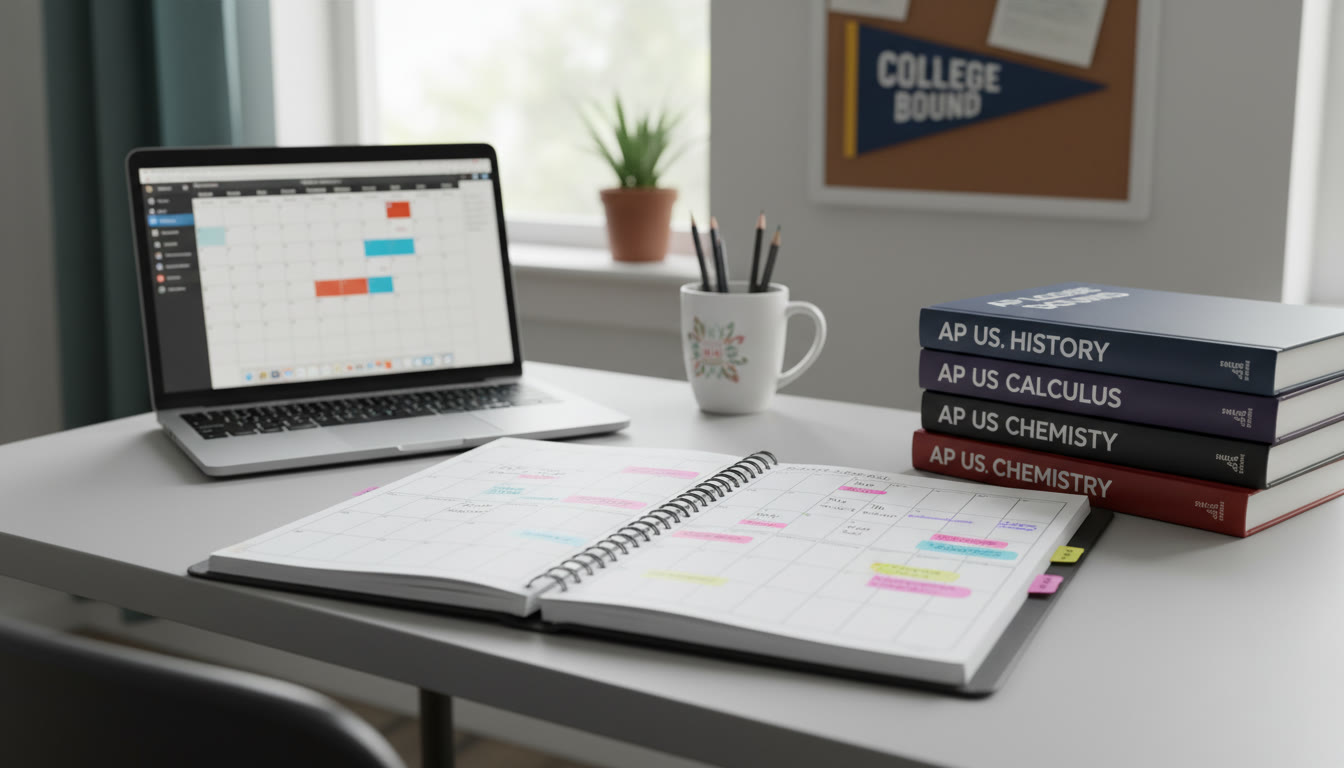Why a Master AP → US Course Planner Changes the Game
Imagine walking into junior year with a map, not a maze. That’s what a Master AP → US Course Planner gives you: clarity, calm, and the confidence to build a transcript that reflects both passion and preparation. For students aiming at top colleges, AP classes are more than just exams — they’re signals. But those signals matter most when they’re consistent, intentional, and aligned with your interests. This guide shows you how to build a single planner that connects AP course choice, study rhythms, extracurricular focus, and college-ready outcomes.

Who this planner is for
This template is designed for:
- High school students (sophomores and juniors) who want to take APs strategically.
- Parents who want to support without micromanaging.
- Students balancing APs with extracurriculars, sports, or jobs.
- Anyone aiming for selective colleges and a strong academic profile.
Core Principles: How Top Students Use APs
Before building the planner, anchor your decisions in a few practical principles. These are the guardrails that keep your plan realistic and compelling.
1. Depth over breadth — with thoughtful exceptions
Colleges want to see you push academically in areas that matter to you. Taking every AP available is tempting, but purposeful depth (three to five APs in subjects that reflect your interests) often tells a clearer story than scattershot APs.
2. Sequence matters
Some APs benefit from a strong foundation (AP Calculus after precalculus, AP Chemistry after a rigorous chemistry course). Map prerequisites so you don’t overreach and risk burnout or lower scores.
3. Balance and sustainability
High-scoring AP students often build routines: consistent review, weekly problem sessions, and scheduled practice tests. Sustainable plans beat sprint-only strategies.
4. Flexibility
Life happens. The best planner is a living document you review quarterly and adjust as grades, activities, or interests evolve.
The Master AP → US Course Planner Template (Step-by-Step)
This section gives you a stepwise template you can adapt to your school’s sequence and your goals. I’ll follow it with an example timeline that shows how a typical student might build their four-year plan into an AP roadmap focused on getting ready for U.S. colleges.
Step 1 — Identify your academic focus and target colleges
Start by writing down 3–5 potential major or interest areas (e.g., Computer Science, Biology, History, Engineering, English). Don’t stress if you change your mind; this step helps prioritize APs.
Step 2 — Audit your current transcript and prerequisites
Make a list of completed courses and grades. Note what your school requires before taking each AP (for example, AP Physics C may require prior physics and calculus).
Step 3 — Choose APs by year and level of commitment
Place APs across sophomore (if offered), junior, and senior years. Consider whether an AP is manageable with your extracurricular load and other commitments.
Step 4 — Build a study rhythm (weekly and monthly)
Create a weekly schedule with fixed study slots — e.g., 3 x 60-minute focused AP sessions per subject plus a weekly practice-test block. Add monthly full-length practice exams and review sessions.
Step 5 — Add benchmarks and contingency plans
Set grade and practice test score milestones (example: 85% in class by October; 3 full practice tests before the exam with an average of 70% or higher). If milestones aren’t hit, define adjustments: reduce course load, get tutoring, or change AP target for exam day.
Step 6 — Integrate extracurriculars, essays, and college prep
Map major extracurricular milestones (leadership roles, project deadlines) alongside AP milestones. Keep college essay brainstorming and recommendation-building on the calendar so they don’t pile on in senior fall.
Planner Components: What to Put in Your Master Sheet
Use a spreadsheet or a large-format paper planner. Each student’s layout will vary, but these columns are the essentials.
| Column | What to Track | Why It Matters |
|---|---|---|
| Academic Focus | Planned major/interests (top 3) | Keeps AP selection aligned with long-term goals |
| Year | Sophomore, Junior, Senior | Ensures logical sequence and workload balance |
| Course | AP Subject and teacher | Teacher quality affects score expectations and study style |
| Prereq/Prep | Class prerequisites and summer prep | Prevents unrealistic jumps into advanced material |
| Study Plan | Weekly schedule and monthly benchmarks | Turns goals into daily actions |
| Milestones | Scores/GPA targets and contingency actions | Keeps momentum and offers corrective steps |
| Support | Tutoring, study groups, office hours | Records where to get help when needed |
How to use the table
Fill this out at the start of each academic year and revisit monthly. For top-college applicants, share a distilled version with your guidance counselor so your course rigor and rationale are clear.
Example: A Four-Year AP Roadmap for a College-Bound Student
This is a realistic example for a student who’s passionate about STEM but wants to keep humanities options open. Adjust for your school and interests.
| Year | Core Courses | Planned APs | Study Focus |
|---|---|---|---|
| Sophomore | Honors Algebra II, Honors Biology, English II | AP Computer Science Principles (if available) | Foundations: algebra, lab skills, disciplined weekly homework block |
| Junior | Precalculus/Calculus AB, Chemistry, US History | AP Calculus AB, AP Chemistry, AP US History (pick 2–3) | Weekly practice problems, monthly practice tests, review groups |
| Senior | Calculus BC or Multivariable, Physics, English Literature | AP Calculus BC (or BC exam), AP Physics C (if interested in engineering), AP English Lang or Lit | Refinement: timed sections, essay polishing, teacher recommendations |
Study Habits That Make a Planner Work
Having a planner is step one. What turns it into results are habits. Here are high-value, practical study habits used by high-achieving AP students.
Active Recall and Spaced Repetition
Make flashcards for equations, vocab, and key dates or concepts, and review them on a spaced schedule. This beats passive rereading every time.
Practice Under Test Conditions
Take full-length practice exams under timed conditions. Simulating test day reduces anxiety and trains pacing — a huge advantage on APs with multiple sections.
Target Weaknesses — Not Time Alone
After each practice exam, categorize errors: content gap, careless mistake, or time pressure. Then attack those categories strategically.
Weekly Synthesis Sessions
Once a week, spend 45–60 minutes synthesizing what you learned that week: make one-page summaries, cross-link topics, and create ‘cheat sheets’ you can quickly review.
When and How to Bring in Tutoring
Tutoring speeds progress when it’s targeted. If you’re repeatedly missing the same concept or your practice test progress stalls for 6–8 weeks, it’s time to add help.
How Sparkl’s Personalized Tutoring Fits Naturally
Personalized support can be a game-changer. For students using external help, look for services that offer 1-on-1 guidance, tailored study plans, expert tutors, and AI-driven insights that track progress. A tutor who integrates with your planner — adjusting the weekly schedule, setting targeted milestones, and modeling exam strategies — makes study time far more efficient. Sparkl’s personalized tutoring, for example, can help translate your master planner into daily action with customized sessions and progress analytics that keep both students and parents informed.
Template: Weekly Planner Page (What a Week Looks Like)
Save this as a printable block in your planner. Rotate subjects each week so you don’t exhaust a single subject during heavy project phases.
| Day | 60–90 Minute Focus Session | 30 Minute Review/Flashcard | Weekly Goal |
|---|---|---|---|
| Monday | AP Calculus practice problems (timed) | Calc formula flashcards | Complete 20 timed problems |
| Wednesday | AP US History essay practice | History timeline review | Outline two past free-response prompts |
| Friday | AP Chemistry lab concepts and practice | Chem stoichiometry flashcards | Finish lab write-up prep |
| Saturday | Mixed practice set (50 minutes) + Review (30 minutes) | Mistake analysis | Identify top 3 recurring errors |
Using Data to Improve — What to Track and Why
Track practice test scores, topic-by-topic accuracy, and timing. Over time, small improvements compound. Keep a log with these fields: date, exam type, raw score, section scores, top 3 mistakes, and adjustment plan. If you use tutoring, share this log so sessions are highly focused.
Example Quarterly Review (How to Adapt Your Planner)
At the end of each quarter, ask these five questions:
- Are my class grades where they need to be?
- Did practice-test scores improve since last quarter?
- Are any APs causing unsustainable stress or detracting from activities I care about?
- Have my college or major interests shifted?
- Do I need to change support (tutor, study group, teacher office hours)?
If answers show slow progress, adjust: drop an AP, switch to self-study for an exam, or increase tutoring frequency. The goal is a transcript and score set that reflect growth, not constant overreach.
Common Mistakes and How to Avoid Them
Mistake: Overloading Junior Year
Why it happens: students think stacking APs junior year maximizes rigor. Reality: burnout and subpar scores. Instead, balance across junior and senior years so you can perform well on exams and still lead in extracurriculars.
Mistake: Ignoring Foundation Courses
Advanced work builds on strong foundations. Don’t skip honors or prerequisite classes just to jump into an AP. Your planner should document the pathway rather than gaps.
Mistake: Waiting Too Long to Practice Full Exams
Start taking full-length practice exams well before the exam window. Early practice identifies pacing problems and content gaps when you still have time to fix them.
Putting It All Together: A Mini Action Plan (30-60-90 Days)
Here’s a short, executive plan to convert your master planner into immediate action.
- 30 days: Complete the master sheet. Schedule weekly study blocks and book 1–2 tutoring sessions if needed.
- 60 days: Finish 1–2 full practice exams. Start targeted review on weakest topics. Adjust weekly schedule based on results.
- 90 days: Solidify pacing and tackle timed FRQ practice. Confirm recommendation and essay planning with teachers and counselors.
Final Thoughts: Your Planner, Your Story
APs are tools — powerful ones — for telling colleges that you’re curious, resilient, and ready for challenge. A Master AP → US Course Planner does more than organize dates and books; it helps you craft a coherent academic story. Keep the plan honest, keep revision frequent, and let your real interests guide which APs you keep and which you let go.
One last practical tip: if you find your planner is getting cluttered or your improvements are stalling, consider short-term, focused tutoring. A smart tutor won’t just explain content — they’ll refine your planner, set realistic milestones, and give feedback that converts practice tests into reliable scores. Thoughtful, personalized help can be the difference between a good score and a great one.

Build this planner, iterate often, and let each AP you take be a clear step toward your goals. You have time, and with a good plan, you’ll use it well.
Want the template?
If you’d like, I can convert this planner into a downloadable spreadsheet template (year-by-year tabs, weekly planner, and a progress dashboard) or a printable PDF. Tell me whether you want focus on STEM, Humanities, or a balanced track and I’ll tailor it to your needs.



















No Comments
Leave a comment Cancel